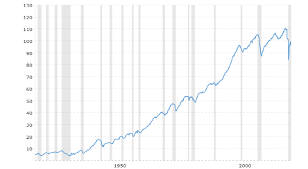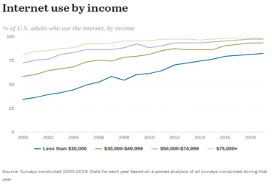
When we think about the global economy, it is not often (if ever) that policymakers, academia, or the financial media cover the market research industry. In years since the Global Financial Crisis (GFC), global gross domestic product was growing steadily at about 2.5 percent year over year[1]. Each year the insights industry is able to contribute to global growth in our own small way: uncovering customer pain points, creating new visualizations, streamlining processes, and implementing new technology to breathe rich insights into key findings. In other words, the insights industry serves the vital role of helping firms solve problems for their customers. It is with this in mind, that we can explore the impact the industry has on the economy and what impact the economy has on the industry.
Smartphones, social media, and internet technologies have become more ubiquitous and accessible to the average consumer than ever before. In 2007, the first iPhone came with a price tag of $499, or $653 today[2], which is just shy of the $699 that the current iPhone 12 fetches. What this means in real terms is that the cost of a new iPhone with all of the advancements of the previous decade, has remained flat—a great thing for the consumer—and insights. As wages increase, more people can buy the newest iPhone. The expansion and accessibility of devices such as the iPhone, has also made the consumer more accessible than ever, giving birth to a new era of methodological innovation in the insights industry. Let’s explore further the relationship between economic expansion and innovation in the insights industry.

The Insights Century
In the 1920s, Daniel Starch, a professor of psychology at Harvard University, developed a theory that for advertising to be effective it must be seen, read, believed, remembered, and acted upon. After his time in academia, he founded his own research firm, Daniel Starch & Staff. The research he conducted was the start of measuring the actual reach of advertising, thus market research was born[3].
A decade later in 1935 the famous statistician, George Gallup, created the method to post-test the effectiveness of advertising. This method, known as “aided recall,” post-tested the effectiveness of advertising where respondents were shown pieces of advertising to assist their memories with the goal of seeing whether they could recall ads without being shown the publication where they appeared[4]. This approach, first used in print, is now ubiquitous in radio and television ad testing[5].
Moving forward into the 1940s, psychologist Ernest Dichter applied Freudian psychoanalytic theory to analyze consumer motivations using qualitative methods. He believed that despite the answers to questions individuals gave about their behavior, they behaved in ways that differed or were contrary to those expressed views. This advancement expanded the tools available to researchers to include the in-depth interview (IDI) to gain deeper insight into these true beliefs or attitudes.
As the decades progressed forward, focus on the actual experience of the customer began to gain traction. During the 1980s and 1990s, researchers began to explore the effect of emotion on consumer behavior. As technology advanced and became more inexpensive, namely recorded focus groups/one-on-one interviews, and computer assisted telephone interviews (CATI), researchers were able to capture more data more frequently. Interestingly, Survey Sampling International (now Dynata) has its roots during this era and remains one of the largest research suppliers in the world.
In the modern era, the advent and subsequent expansion of the internet access has initiated an explosion of innovation in the research industry. Insights firms are now able convert the methodological breakthroughs of the past and put them online. IDIs can now be transformed into asynchronous online focus groups. Surveys can be design, fielded, and reported on in more abundance and more condensed timeline. Commercially available insights software and reporting tools have become ubiquitous and essential. Gone are the days where it takes weeks or months to go from recruiting to actionable insights. The result: faster, cheaper, and better.
The Global Economy & Market Research
As we have briefly explored, it has been a long and insightful journey over the last century. The breakthroughs made by the pioneers mentioned and those unmentioned have shaped our current understanding of consumer behavior and, more importantly, the techniques on how to uncover the deepest of insights into the consumer.
Through this journey the global economy was expanding rapidly. More and more manufactured goods were more accessible than ever. After the Great Depression of the 1930s and a brief recession from 1945 to 1946, global output has consistently expanded year over year, with some relatively minor bumps in the road along the way. For instance, global Gross National Incomes (GNI) rose from $590 in 1965 to $1,547 in 1975 on a per capita basis (see figure above). Along with this nearly three-fold increase in global income came an expanding middle class and potential customer base for new products and services. Through world wars, a battle with inflation as experienced by the United States in the late 70s, the Global Financial Crisis of 2007-08, and the COVID-19 pandemic, the trend continues to this day, leaving fertile ground for the insights industry to help their clients acquire more customers as upward income mobility continues to expand around the globe.

Through the economic ups and downs (mostly ups) the global market research industry has grown to a more than $70 billion industry, with the top 10 suppliers making up about a quarter of the revenue.[5] This leaves a sizeable market share for smaller, boutique firms to carve out their own niche in the industry—innovation for innovation!
This is extremely important as economies continue to become more advanced, diversified, and complex. As supply and demand for new products and services emerge in the global marketplace, companies must discover ways to solve problems and make the lives of consumers better. The challenging part is knowing these hidden desires even before they know it themselves. As Henry Ford once said, “If I had asked people what they wanted, they would have said faster horses.”

Even through turbulent economic periods, firms must continue to seize on the opportunity to innovate. As you can see in the chart on the left, the market research industry only contracted very briefly in the wake of the global financial crisis, meaning firms continued to place high value on understanding their customers as they did prior to this period of particularly high uncertainty. It was also during this period where mobile technologies became more accessible to the average consumer than ever before. Internet access. As indicated in the chart on the left, internet usage by households earning less than $30,000 per year in the year 2000 was 34 percent. By 2021, 86 percent of households in this same demographic say they use the internet—an astonishing increase in access.

Drawing the picture wider, a mobile phone service plan that costed $50 per month in 1997, costs $24.10 per month in 2021—a more that 50 percent decline.[6] Now you may be thinking, why am I paying $70 per month or more for my plan now? Well, we must factor in the inflation of the money supply and rising cost of labor (or colloquially called wages) over two decades, which causes prices across the economy to rise. Therefore, what is really going on here is that the plan that would cost $50 per month in 1997, should really cost about $100 per month in 2021. Furthermore, the technology available in mobile devices and networks is a far cry from the heavy shoebox size mobile phones that were available in 1997. So, how do we square that circle? How is it possible that in real terms, the cost of mobile phone service has decreased over time and have so much more to offer the consumer? The answer, of course, is through innovation, not just in technology, but in processes, manufacturing, materials, and messaging to the consumer. Why am I talking about all of this? Let us bring it full circle.
A Modern Insights Toolkit
The last century has been a period of great progress in furthering our understanding of consumer behavior. All throughout the global economy was expanding, providing opportunity for insights industry to expand their footprint across verticals. The insights industry had a plethora of tools to deploy to discover not only customer needs, wants, and desires, but who they are. At KLC, we use methods that are a blend of traditional and non-traditional methods.
- Traditional: Synchronous, real-time, in-person, CATI using quantitative and qualitative methods.
- Non-Traditional: Asynchronous methods using market research online communities (MROCs) that create a consistent feedback loop between companies and their customers.
The insights industry operates like any other typical sector in the economy, with firms ranging from large multi-nationals to the smaller boutique shop. For instance, KL Communications has its own propriety methodology, CrowdWeaving® that uses the principles of design thinking to unlock the potentially revolutionary ideas for the next innovation. Briefly, design thinking is a step-by-step approach to creative problem solving and innovation by gathering data from a target audience to develop new or enhance existing products and services. Put simply, CrowdWeaving® puts producers of products or services at the very early stages of the innovation process. In fact, it works best when a client comes to us with a problem, they want to solve for the their customer, or potential customer to expand their market share.
Conclusion
So why all this talk about the economy, consumer behavior, research methods, and the development of new technologies? Economic development and market research go hand in hand. Indeed, it may seem like the natural progression of human history that markets will become more complex and expand. However, along with entrepreneurs, high finance, scientists, engineers, transportation, energy, and all the other cogs in the wheel that make markets function, market researchers are the messengers between the consumer and the decision-makers. Research and development might have a great idea, in their view, but if the idea (or product) does not solve a problem for the consumer or relieve a pain point, the idea is doomed to fail. Research is the oil in the engine that allows it to function properly. Engaging consumers in ongoing, reciprocal conversation is the only way to increase the chances of success to tap into their deepest needs—which is a key tenant to the evolution of human social progress and survival. Again, sometimes consumers do not know what they desire. It is up to the market research professional to not just deliver the message but interpret the answers they give to actionable steps to take to fulfil them. The expansion of internet access spoken about previously, has enabled firms and researchers to converse with consumers easily, faster, and more inexpensively than ever—a great thing for the bottom line.
At KLC, we tap into the consumer’s desires by facilitating that conversation through MROCs. Traditional research of this depth is often costly and time-consuming. However, an MROC provides the means to very quickly engage consumers who are very interested in helping their favorite brands or products become better. After all, the consumer wants these problems solved just as much as the producer, the fundamental value of the market. Whoever solves the problem better, faster, or cheaper wins. Particularly in the post-COVID world, consumers are going to be looking ways to make their money go further. This may sound like it could be a detrimental to innovation, but a period of economic turmoil can be the perfect opportunity to unleash the awesome power of the consumer through an MROC. There’s an old saying “Market or die.” However, in these economic times, the saying should be “Innovate or die.” Understanding who your consumer is essential and the methods deployed by KLC that better understand the customer is the best way to innovate and succeed in uncertain times. After all, a firm’s competitive edge relies on its ability to adapt and reach more customers, period.
Want to learn more about what KLC has to offer? Let us know!